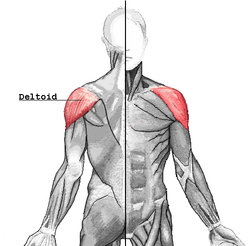Deltoids
| Deltoid muscle | |
|---|---|

Deltoid muscle
|
|

Muscles connecting the upper extremity to the vertebral column
|
|
| Details | |
| Origin | the anterior border and upper surface of the lateral third of the clavicle, acromion, spine of the scapula |
| Insertion | deltoid tuberosity of humerus |
| Artery | thoracoacromial artery, anterior and posterior humeral circumflex artery |
| Nerve | Axillary nerve |
| Actions | shoulder abduction, flexion and extension |
| Antagonist | Latissimus dorsi |
| Identifiers | |
| Latin | musculus deltoideus |
| Dorlands /Elsevier |
m_22/12548745 |
| TA | A04.6.02.002 |
| FMA | 32521 |
|
Anatomical terms of muscle
[]
|
|
In human anatomy, the deltoid muscle is the muscle forming the rounded contour of the shoulder. Anatomically, it appears to be made up of three distinct sets of fibers though electromyography suggests that it consists of at least seven groups that can be independently coordinated by the nervous system.
It was previously called the deltoideus (plural deltoidei) and the name is still used by some anatomists. It is called so because it is in the shape of the Greek capital letter delta (Δ). It is also known as the common shoulder muscle, particularly in other animals such as the domestic cat. Deltoid is also further shortened in slang as "delt".
A study of 30 shoulders revealed an average mass of 191.9 grams (6.77 oz) in humans, ranging from 84 grams (3.0 oz) to 366 grams (12.9 oz).
The deltoid originates in three distinct sets of fibers, often referred to as "heads":
Fick divided these three groups of fibers, often referred to as parts (Latin: pars) or bands, into seven functional components: the anterior part has two components (I and II); the lateral one (III); and the posterior four (IV, V, VI, and VII) components. In standard anatomical position (with the upper limb hanging alongside the body), the central components (II, III, and IV) lie lateral to the axis of abduction and therefore contribute to abduction from the start of the movement while the other components (I, V, VI, and VII) then act as adductors. During abduction most of these latter components (except VI and VII which always act as adductors) are displaced laterally and progressively start to abduct.
From this extensive origin the fibers converge toward their insertion on the deltoid tuberosity on the middle of the lateral aspect of the shaft of the humerus; the middle fibers passing vertically, the anterior obliquely backward and laterally, and the posterior obliquely forward and laterally.
...
Wikipedia
